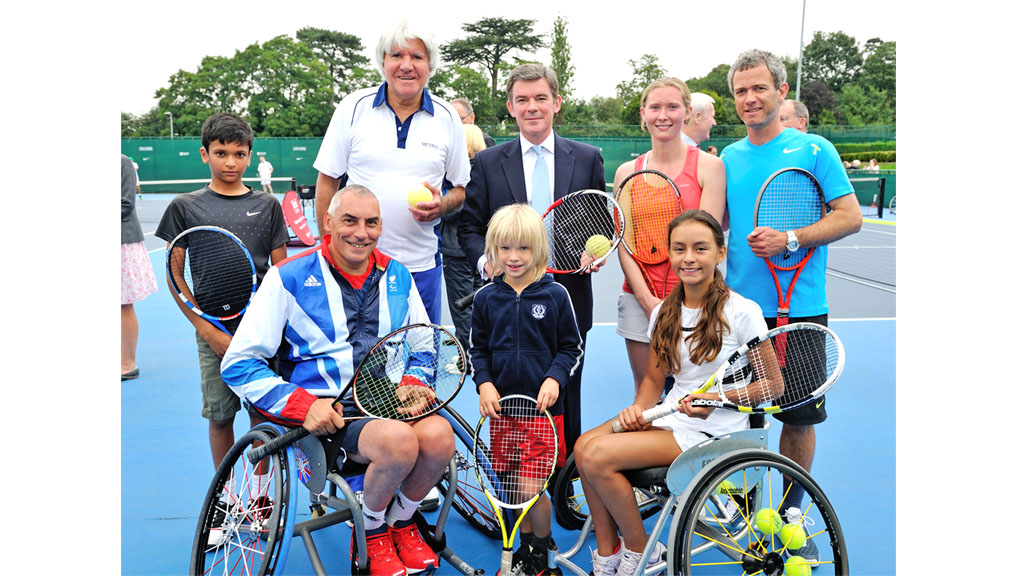Disability tennis seeks stars of the future
While Britains number one Andy Murray was defending his US Open title this week, the sport’s governing body was aiming to inspire a generation of young disabled players to reach similar heights.

(Sports Minister Hugh Robertson, centre back, and Paralympian Peter Norfolk, front row far left)
The Lawn Tennis Association (LTA) and charity Tennis Foundation held a disability tennis festival this week to showcase some of the youngsters we hope will shape a successful future for British Tennis at Rio 2016 and beyond, writes Jordan Jarrett-Bryan.
According to the BPA (British Paralympic Association), wheelchair tennis is the fastest growing Paralympic sport since 2012, with participation up by 70 per cent since January.
Tennis Foundation is keen to build on that, but it’s important to note that disability tennis is not confined to people in wheelchairs.
All the adaptations of tennis that are available across the country were on show at the LTA head quarters, including learning disability, deaf and visually impaired competitors.
But despite the most successful Paralympic Games in its history, most people won’t know anything about wheelchair tennis, let alone the wider spectrum of disability tennis.
And why would they? How can a sport grow, if we don’t see it?
But a lot of the clamour for instantaneous change within disability sport is just unrealistic – something that retired Paralympian, Peter Norfolk recognises: “It’s gonna take time. The Games was a huge eye opener for the British public, but we need to be patient and keep the momentum going.”
Norfolk, known as the quad father, because of his legendary status within the game and because he competes in the quadriplegic division of wheelchair tennis, also wants youngsters to stop just watching and actually try playing sport:
“So many young people watch and enjoy sport. But what’s stopping them actually doing it? Rather than watching Tennis, I ask, why aren’t you playing Tennis?”
Not everyone is going to be good at sport, but Norfolk doesn’t understand why more don’t try. He continues:
“If you’re disabled and like tennis, there’s no excuse to not play. All you need is a racket, ball and net”, he says.
Peter Norfolk is pleased to see the work the LTA is doing, but would like to see more and has recently set up his own academy:
“I think we need to be approaching more (disabled) youths and letting them know just because you have an amputation that doesn’t mean you have to go into track and field or wheelchair basketball.
“Tennis isn’t a come down, we need to change the attitudes of young people to sport and then we’ll widen our pool of top athletes at Paralympic Games”, he concludes.
The media have played their part in showing the nation what disability sports are out there and now it’s up to disabled people to visit their nearest club and have a go.
Ongoing coverage
Chief Executive of the BPA, Tim Hollingsworth was full of praise for the media during the Paralympic Games and challenged all outlets to continue the coverage when it’s deserved:
“I thought the coverage was great and more than we expected. Our athletes were getting front page coverage of national sports pull outs and Channel 4 completely understood what needed to be done”.
Despite a concern the host broadcaster could over do tales of how athletes lost a limb or lost the use of their legs, Hollingsworth was delighted to see the channel treat the event as the world class sporting event it is:
“We didn’t want to focus too much on the stories behind the athletes, but show the nation what they could do in the sporting arena”.
-
Latest news
-
Taylor Swift’s new break-up album breaks records3m

-
NHS trust fined £200K for failings that led to death of two mental health patients3m

-
Sunak vows to end UK ‘sick note culture’ with benefit reform3m

-
‘Loose talk about using nuclear weapons is irresponsible and unacceptable’, says head of UN’s nuclear watchdog3m

-
‘There wasn’t an Israeli attack on Iran,’ says former adviser to Iran’s nuclear negotiations team7m

-




